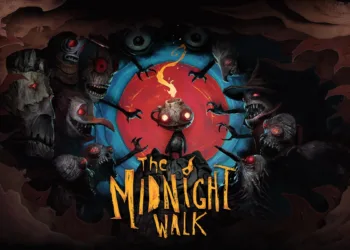The Salt Path, released in 2024, tells the real-life story of Ray and Moth Winn, who lose everything after their bed and breakfast go bust. Directed by Marianne Elliott, it stars Gillian Anderson as Ray and Jason Isaacs as Moth. Facing homelessness and the devastating news of Moth’s terminal illness diagnosis, the couple embark on a journey along England’s rugged coastal path that will test their physical and emotional limits.
Traversing over six hundred miles, Ray and Moth confront unforgiving terrain, fickle weather, and unfriendly strangers. They battle tiredness, hunger, and the advance of Moth’s condition with nothing but backpacks and tents between them and the elements.
Yet amidst the hardship, fleeting acts of kindness offer hope and remind them of our shared humanity. Through their walk, Ray and Moth seem to find healing in each other and reconnection with the beauty of the natural world surrounding them.
This review will discuss the film’s emotional exploration of love, resilience, and finding purpose in difficult times. It will analyze the performances at their heart and consider important themes like homelessness and health issues. Ultimately, it aims to convey the impact of The Salt Path experience—an intimate drama that offers an inspiring message to anyone facing adversity in their own lives.
The Long Road Ahead
Things sure took a turn for Ray and Moth. They’d sunk their funds into a bed and breakfast, hoping it would finance a comfortable retirement. But business wasn’t booming like they’d planned. On top of that, some risky investments went south, leaving the couple in serious debt. The losses and stress took a toll. Then, as if things couldn’t get worse, Moth receives a diagnosis that stops him in his tracks—his health is declining due to a degenerative disease.
Facing homelessness with little options and time perhaps running out, it’s no wonder Ray suggests they hit the open road. Her and Moth share a deep love, evident in the tender way they support each other through hardship. Gillian Anderson and Jason Isaacs portray this bond beautifully. Now all Ray and Moth can do is walk westward, putting one foot in front of the other along England’s southern coastal path.
The film mostly follows their journey, meeting fellow travelers along the way. Some offer kindness, others less hospitality. Through it all, Ray and Moth make the most of their time together. Faced with unforgiving terrain and fickle weather, their spirit and determination see them through. Yet the physical challenges are matched with emotional trials as Moth’s condition progresses and parts of their old life now seem out of reach.
The story shows how walking becomes more than just moving forward—it’s a chance to heal, reflect, and live fully in the moment despite looming uncertainties. Ray and Moth support each other as only true companions can, finding solace in each small victory achieved side by side on the long road ahead.
The True Hearts of The Journey
Man, Gillian Anderson and Jason Isaacs really brought Ray and Moth to life. From the very start, their relationship felt so real and genuine. You could see the bond formed over many years together, even in the small gestures between them. It’s what kept me invested in their story.
Anderson and Isaacs put it all on the line with their intimate portrayals. They showed the physical impact hardship was having—you could see the weathering of circumstances literally on their faces. But more than that, you felt the depths of emotion they conveyed without overdoing it. When Moth’s condition worsened, or during quieter moments of sadness, so much was understood just from their mournful expressions.
I loved how they subtley gave insights into Ray and Moth’s thinking too, through fleeting facial expressions or body language. One scene has Ray distractedly staring off after a villager’s rude comment, clearly remembering happier times. And you could really feel Moth’s fear as well as love when he squeezed Ray’s hand tightly during a storm. It was these understated details that brought their characters to life.
Both actors are completely committed to their roles. They walked the trail together day after day, building real rapport you saw in their tender glances and support for each other. That’s what kept The Salt Path so intimate and their journey so impactful—the true hearts Anderson and Isaacs brought to the screen as that remarkable couple at the film’s core.
Bringing The Journey to Life
Man, kudos to director Marianne Elliott for how she brought Ray and Moth’s walk to the big screen. She knew showing the beauty around them was key, but in a raw way that felt real. Like the English countryside is stunning, right, yet those rolling hills can beat you down when you’re struggling. You could feel the exhaustion in sweeping shots of those paths stretching on forever.
Cinematographer Helene Louvart for sure captured it all gorgeously. Landscapes popped with the textures of dried grass or crashing waves. But she framed it in a way hinting at nature’s power over our heroes. Their tiny figures against a darkening storm sky—you knew they were in for it. It was like seeing the story through Ray and Moth’s eyes as their world closed in and opened up each day.
And kudos to the design team too. Ray and Moth’s worn clothes and gear had you sweating right along with them in the sun. They blended seamlessly into scenes without upstaging the beauty. But you also saw how the crowds stood out in comparison, foreshadowing how Ray and Moth struggled to fit in anywhere.
Then there’s how sound and little details added so much without being obvious. Like hearing Heaney’s words put you right in Moth’s headspace during his worst moments. Or how weather shifts mirrored Ray and Moth’s ever-changing mindsets. Elliott sure knew how to let the visuals enhance what the characters showed through their actions alone. It all comes together perfectly to immerse you in their journey.
Finding Purpose on the Path
Man, The Salt Path sure tackles some heavy themes. But it does so in a hopeful way that’ll likely stick with you. A big one is resilience—how two people can support each other through anything when they’re all they have. You see it as Ray and Moth push on mile after mile, even as Moth’s health worsens and money runs out. They demonstrate what real love means—being there through all of life’s crap.
It also shows how important compassion from strangers can be when struggling. From a kindly couple offering pastries to a man buying them ice cream, small acts of kindness go a long way. The film puts us in those moments to reflect on lending a hand whenever we’re able. At the same time, it highlights issues with systems that are meant to help but fail people going through hardship. Whether with housing or the courts, sometimes it feels like society abandons folks.
Nature itself emerges as almost a character that both threatens danger yet provides strength. You can’t help but be in awe of the landscapes, but they properly reflect how the elements can wear someone down. Yet even as the world closes in, Ray and Moth seem to rediscover a sense of peace in the beauty before them each day. It invites thinking about where we find purpose—is it career, family, or something simpler like embracing the present moment?
Most of all, The Salt Path celebrates life’s fragility and teaches not to sweat the small stuff. Ray and Moth are living each step to the fullest even as mortality looms, determined to make the most of the time they have together. It’s moving to see two people so fully devoted to each other in all circumstances, good and bad. The film inspires pondering what really matters most and how to make the most of the gift that is each day.
The Journey’s Resonating Steps
Man, The Salt Path sure left some footprints. I’d be lying if I said it didn’t stir me up a bit during those sadder scenes. But Marianne Elliott walks a fine line between moving an audience and flat-out manipulation. A few moments felt too heavy-handed for tears over Ray and Moth’s love.
Still, it rightfully earns comparisons to classics like Wild that showed determination in the face of hardship through epic walks. Yet where Salt Path stands out is its heart. It’s intimate look at two people sharing their most personal struggles and fondest memories kept it real in a way grand cinema cannot.
Despite drags in parts, I left thinking how Ray and Moth’s resilience in their darkest hour inspired getting through life’s difficulties. Their walk reminded me that we’re stronger tackling problems together and finding purpose in each other and nature’s simple beauty. It asks what’s really important when adversity strikes.
More than entertain, Salt Path meaningfully spotlights real social issues too—from terminal illness and homelessness to failing systems. Their story highlighted the human impact of such crises, which lingers with me. And it effectively stirred discussion on these topics amongst others who saw it.
Overall, while not flawless, Salt Paths leaves resonance through the footsteps of Ray and Moth we follow, a story touching something universal inside all who walk their inspiring path. Its intimacy is what makes its message of hope continue echoing.
The Path’s Lasting Footprints
Overall, despite drags here and there, The Salt Path gets so much right. Marianne Elliott’s natural storytelling and the heartfelt performances from Gillian Anderson and Jason Isaacs make it an emotional watch. While not perfectly paced, its themes of resilience, love, and finding purpose in life’s beauty are impactful.
As Ray says in one scene, “‘This is a new start. All that’s behind us now.’ And that’s really what their journey symbolized—that even in the toughest of times, as long as you’ve got someone by your side, each new day can offer hope.” That message will continue echoing long after the film.
While heavier than some, The Salt Path delivers well on showcasing real struggles facing people today and sparking discussion. Its intimate look at two special individuals and what really matters most gives their inspiring walk beautiful meaning. I’d say it’s well worth taking in for anyone seeking an emotional drama packed with staying power.
So in closing, thanks for taking the time to walk alongside me in discussing Ray and Moth’s moving journey. I hope their story, for all its imperfections, continues to leave lasting footprints wherever its message reaches in the days ahead.
The Review
The Salt Path
While not without its flaws, at its heart, The Salt Path tells an impactful human story about resilience, love, and finding purpose. Driven by Gillian Anderson and Jason Isaacs' emotionally authentic performances, it invites reflection on facing life's difficulties with compassion for others and appreciation for simple beauty in each moment. Director Marianne Elliott crafts a movingly intimate drama that will continue to leave its marks on those who embark on Ray and Moth's inspiring journey.
PROS
- Strong central performances that emotionally carry the film
- Beautiful natural cinematography that enhances the themes
- An inspiring message of resilience, love, and finding meaning in difficult times
- Raises thought-provoking issues of homelessness, health struggles, and failing social systems.
- Intimate perspective that invites self-reflection
CONS
- Narrative pacing drags in some parts.
- Overly manipulative emotional cues on occasion
- Subplots and secondary characters not fully resolved
















































